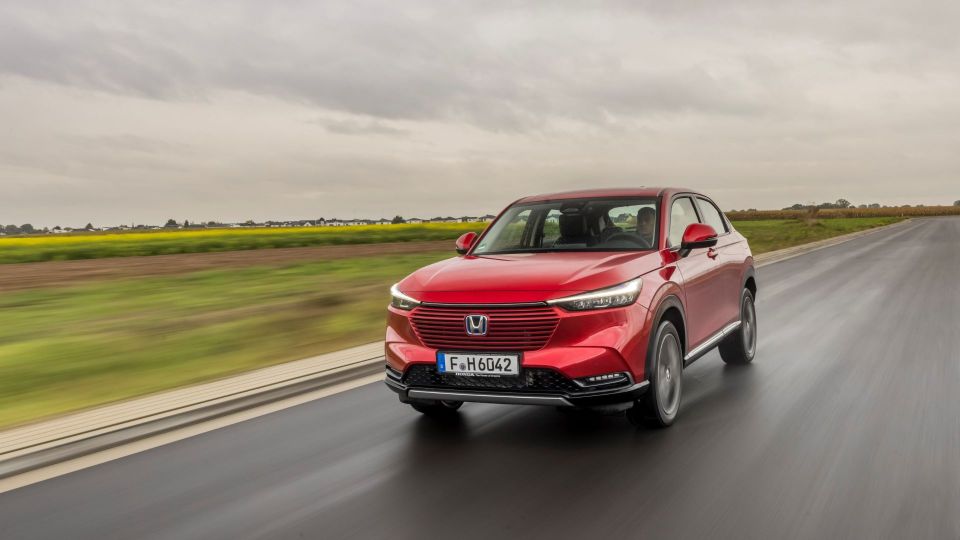Honda HR-V 2022 review: All that Jazz

When asked “What car should I buy?”, Jeremy Clarkson famously used to answer without hesitation: “a Ferrari F40”. I’ve never been lucky enough to drive an F40, but I had one on my bedroom wall and suspect Britain’s most famous farmer may be right. When I’m asked the same question, though, I usually reply “a Honda Jazz”.
Now, I won’t pretend a 1.5-litre hybrid offers the same visceral excitement as a 2.9-litre twin-turbo V8. Nor that the Japanese supermini looks as punchy on a poster as the Italian supercar.
But when I worked at Which?, the Jazz finished first in our ownership survey every single year. It’s hugely practical and utterly reliable. And that’s what most people want from a car.
Batteries included

Or is it? Some have taken my advice and bought a Jazz (my mum, for one), but others can’t look past its box-on-wheels silhouette and OAP image. If that sounds like you, Honda offers something rather more fashion-forward: the new, third-generation HR-V.
The HR-V uses the same petrol-electric hybrid drivetrain as the Jazz, albeit with more power and a 25 percent bigger battery. A combined 131hp serves up 0-62mph in 10.7 seconds and decent 52.3mpg economy.
Unlike some hybrids, you can’t plug in the HR-V to boost battery range, but Honda says it operates in zero-emissions EV mode for 91 percent of town driving. Instant electric torque makes it feel responsive in traffic, too.
Escape to the country

Outside urban areas, the HR-V is less impressive. Its e-CVT automatic gearbox holds the engine at high revs when you accelerate, while its light steering feels rather artificial. Switching to Sport mode makes little perceptible difference.
Ultimately, there’s no shortage of grip and cornering poise, but don’t expect to venture far off the tarmac. Despite its SUV styling, the Honda is front-wheel-drive only.
You could even describe the HR-V as a coupe-SUV, so sloped is its rear roofline. Whatever the semantics, it’s a very on-trend shape in 2022. Crisp contours and distinctive details, such as the bolt-upright grille and full-width rear light bar, lend a futuristic feel.
It stands out in a class full of bold designs, including the Vauxhall Mokka and Nissan Juke.
A kind of Magic

The price paid for that sleek C-pillar, of course, is reduced practicality. Boot capacity with the rear seats up is 304 litres: no better than the smaller Jazz. I can hear my mum tutting from here.
In the HR-V’s defence, it borrows the Jazz’s ingenious Magic Seats, with bases that flip upwards to allow floor-to-roof storage for tall objects. “Perfect for carrying lime trees home from the garden centre,” apparently.
Elsewhere, the Honda is less radical inside than out. Its most interesting feature are the L-shaped corner vents, which waft hot or cold air along the sides of the cabin, rather than blowing it in your face. Build quality is excellent, as you’d hope, and the touch-points on my mid-range HR-V Advance were trimmed in tactile synthetic leather.
All versions come with an intuitive 9.0-inch central touchscreen, which connects to your phone wirelessly via Apple CarPlay or Android Auto.
Consumer advice

Priced from £27,960, standard equipment on the HR-V includes heated front seats, automatic wipers and LED headlights. It also has all the driver assistance tech you’d expect, such as lane-assist, front and rear parking sensors, adaptive cruise control and a reversing camera.
Easy to drive and easy to live with, backed up by Honda’s proven reliability record, the HR-V makes a convincing case for itself.
Me? I’d save £8,000 and buy the equally practical Jazz, then have an F40 for weekends. Perhaps Jeremy and I can both be right.
Tim Pitt writes for Motoring Research
PRICE: £29,220
POWER: 131hp
0-62MPH: 10.7sec
TOP SPEED: 106mph
FUEL ECONOMY: 52.3mpg
CO2 EMISSIONS: 122g/km